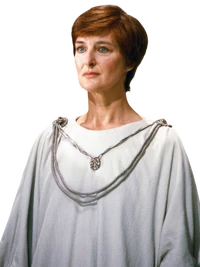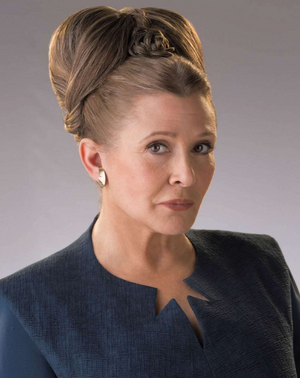- "Democracy is not in need of defense. People are. And it's why we'll keep the ten percent. A peacekeeping force. The rest of our efforts will go toward training the militaries of other worlds. We will be a true Galactic alliance, and not a false one with an authoritarian sun at its center."
- ―Chancellor Mon Mothma
The Military Disarmament Act was the legislation passed by the Galactic Senate of the New Republic in 4 ABY near the end of the Galactic Civil War between the Republic and the Galactic Empire that was to limit the makeup and operations of the Republic's navy and army, reducing the overall size of the centralized New Republic Defense Force by ninety percent. The disarmament movement was undertaken in an effort to reflect the values of a democratic peacetime government and allowed the newly-formed Republic to focus on political cooperation instead of military control as its primary means of civil organization. The Military Disarmament Act also acted as a mechanism to legitimize the mandated disarmament of the remnants of the Imperial Military as outlined in the Galactic Concordance peace treaty that ended the war, further promoting the goal of a peaceful coexistence between the Republic and the Imperial remnants.
The act was originally proposed by Chancellor Mon Mothma, who had worked to prevent growing militarization of the previous Galactic Republic decades prior during the Clone Wars. Her efforts failed during the rise of the Empire and the following years of Imperial domination saw an unprecedented expansion of martial control and authoritarianism. Although Mothma ultimately turned to armed revolution that sparked the Galactic Civil War, she remained committed to the goal of a demilitarized galaxy and hoped to eventually be able to disarm both the Imperial remnants and her own Alliance to Restore the Republic. When the Alliance reorganized into the New Republic after the Battle of Endor, the chancellor moved quickly to propose the Military Disarmament Act and relinquish the military powers vested in her office.
Despite concern about the potential dangers of the various Imperial remnants' forces, the Military Disarmament Act was passed shortly after the Senate convened and implemented following the end of the war at the Battle of Jakku. Over the next three decades, the military restrictions imposed on the Republic allowed the former Empire to rearm and reorganize into the First Order with impunity and stymied efforts to protect against the Imperial successor state's encroachments. Opponents of disarmament, like Princess Leia Organa, found themselves largely shunned from the day-to-day politics of the Republic, which ultimately motivated the creation of an unauthorized military movement called the Resistance designed to perform operations that were prohibited by the Military Disarmament Act and Galactic Concordance.
Description[]
- "I will today put up a vote that resolves to cut our military presence by ninety percent once we are able to officially confirm an end to this war."
- ―Chancellor Mon Mothma

The New Republic had a large-scale military at its beginning.
The Military Disarmament Act was legislation aimed at legitimizing the transition of the Alliance to Restore the Republic from a military resistance movement into a democratic New Republic by significantly reducing the size and scope of its centralized defense forces. The initial proposal called for a ninety percent reduction of the New Republic military, which then consisted of a starfleet, a ground-based combat army, and a Special Forces division. While the remaining ten percent would be retained for small-scale defense efforts, all other military investments were to be diverted to training the local armed forces of Republic member worlds. Beyond the proposed plan reducing the entire military by ninety precedent,[2] the starfleet in specific would itself be reduced by ninety-precent under the final act.[4]
The act was championed[5] and pushed through by Chancellor Mon Mothma,[4] who sought to reject the militarization concepts left behind by the Galactic Empire,[5] which had used a massive Imperial Military to maintain its total rule over the galaxy.[6] Mothma, instead, hoped to establish a government based upon ideals, instead of creating it by force.[5] The provisions of the act would only be implemented after the official end of the Galactic Civil War between the Republic and the Empire.[2] The regulations were also supposed to bind the First Order, but that regime ignored the Act's ruling when creating the First Order military.[7]
History[]
The age of militarism[]
- "It is with great reluctance that I have agreed to this calling. I love democracy. I love the Republic. The power you give me I will lay down when this crisis has abated. And as my first act with this new authority, I will create a Grand Army of the Republic to counter the increasing threats of the Separatists."
- ―Palpatine militarizes the Galactic Republic
Although large-scale military forces were commonplace during the era of the Old Republic, the rise of the modern Galactic Republic ushered in several centuries of a demilitarized central government. During that time, local defense forces and Judicial law enforcement officers were the primary iteration of armed peacekeepers while corporations built massive private armies to protect and enforce their interests.[9] In the twilight years of the Galactic Republic, the Sith Lord Darth Sidious manipulated those corporations into arming a Secessionist Movement and forming the Confederacy of Independent Systems to stand against the Republic.[10] Fears over Separatist aggression motivated the Galactic Senate of the Republic to move towards the passage of the Military Creation Act, which would establish centralized Armed Forces to protect the thousand-year-old democracy. Tensions between the Republic and Separatist movement peaked after the Republic learned of the size and significance of the Confederacy's army of battle droids, motivating the Senate to grant emergency powers to the Supreme Chancellor of the Republic—a position that was then occupied by Sheev Palpatine, the alter ego of Darth Sidious.[11]

In its time, the Grand Army of the Republic was one of the largest and most advanced military forces the galaxy had ever seen.
Palpatine used those powers to approve the usage of a massive, cloned military force to form the Grand Army of the Republic and reestablish a Republic Navy equipped for warfare on a galactic scale.[9] Throughout the three years of the resulting Clone Wars between the Republic and Confederacy, the militaries continued to swell in size while Sidious exerted control over both.[11] In his role as Supreme Chancellor, he ultimately gained direct command authority over the Grand Army and used it to defeat the Confederacy and transform the Republic into the first Galactic Empire. As Galactic Emperor, Palpatine promised a New Order of peace and liberty, but instead worked to increase the size and technological capabilities of the newly-formed Imperial Military.[9] The Age of the Empire reflected an unprecedented era of militarism, during which the martial forces of the New Order represented the Empire itself and enforced Palpatine's rule with brutal suppression of dissent, in the name of keeping the peace that was granted to the galaxy after the Jedi Purge and the Separatist Alliance's final defeat.[12]
During the first two decades of the Empire's rule, small cells of anti-Imperial resistance forces organized an informal rebellion that eventually came under the direction of Bail Organa of Alderaan and Mon Mothma of Chandrila, both former members of the Imperial Senate. Together, they founded the Alliance to Restore the Republic, a military resistance movement aimed at overcoming the Imperial war machine and restoring a democratic government that Palpatine worked so hard to destroy.[11] Although the Alliance was at a disadvantage against the heavily-populated, well-funded, and impressively equipped Imperial Military, it was able to recruit enough soldiers and acquire enough vessels to raise a fleet capable of waging war on a galactic scale.[13]
The Alliance's military might fluctuated throughout the Galactic Civil War but ultimately eclipsed the Empire's after the Battle of Endor where the Imperial Navy and Army incurred massive losses. Palpatine and a number of his top lieutenants were killed in the battle as well, causing a fractured Empire to rapidly fall into a long string of military defeats. The sudden decline of Imperial authority caused an equally sudden increase in volunteer recruitment for the forces of the Alliance as it began the transition into a legitimized New Republic. With an apparent victory close at hand, Mon Mothma shifted from her role as leader of the Alliance into Chancellor of the Republic under the Charter of Chancellor, which retained the emergency authority seized by Palpatine during the Galactic Republic's twilight. Mothma quickly called for a reestablished Galactic Senate to convene on Chandrila and began preparations to surrender her military authority[2] in a rejection of the military ideals left behind by Palpatine.[5]
Proposal and implementation[]
- "War is terrible. And an army isn't enough to fix problems. We need a solution for what happens after they do their job, and that's why the Senate is beginning again…"
- ―Olia Choko
In the months following the Battle of Endor, Chancellor Mothma toured battlefields of the Galactic Civil War and consulted with her advisors about her relinquishment of emergency powers and the eventual demilitarization of the New Republic. Although both proposals stirred controversy among her aides, Mothma was committed to bringing an end to the era of galactic-scale militaries and so proposed the Military Disarmament Act at the first session of the new Galactic Senate.[2] The law was pushed through by Mothma,[4] but its provisions for disarmament were not to be triggered until the New Republic confirmed an ultimate victory in the war.[2] Hoping to distance herself from Palpatine's time in office,[4] Mothma also began the process of relinquishing her emergency authorities[2] inherited from Palpatine's time in office[4] by redirecting military control to a council of martial leaders that made up the New Republic Command.[2]
The Galactic Civil War continued until approximately a year after the Battle of Endor, when the Imperial remnant amassed its forces around a strategically important weapons facility on the planet Jakku in the Western Reaches. The New Republic launched a massive assault on the world and routed the Empire in one of the largest battles of the war. The fighting was brought to an end by the signing of the Galactic Concordance—the historic peace treaty that ended the war and saw the Empire surrender its claim to the galaxy and its military might.[1] Although surviving Imperial forces retreated behind treaty-drawn boundaries in the Core Worlds and Inner Rim, the New Republic military was ordered to maintain its combat readiness until at least a month after the surrender.[14] All remaining Imperial loyalists ultimately participated in a mass exodus to the Unknown Regions, leaving the New Republic to enjoy a period of relative peace and begin the disarmament process.[1]
Ramifications[]
- "Have you heard of the Resistance, Poe?"
"Rumors, mostly."
"Such as?"
"Such as there's a splinter of the Republic military that…that feels the Republic isn't taking certain threats as seriously as they might ought to be taking them. Specifically the threat posed by the First Order." - ―General Leia Organa and Poe Dameron

A small number of X-wings found their way into Resistance service.
In the years following the passage of the Military Disarmament Act, the New Republic fulfilled its obligation to demilitarize, reducing its Starfleet down to a fraction of what it had been during the height of the Galactic Civil War. Given the forced disarmament of the Imperial remnant, the New Republic military still remained the largest in the galaxy but operated in a severely limited capacity. The production of capital ships was significantly reduced,[1] requiring Rebellion-era vessels like the MC80 Star Cruiser Home One to remain in service for decades after the war.[3] Although the military wares manufacturer Incom-FreiTek Corporation continued to develop new X-wing starfighter models for the New Republic,[15] the disarmament effort and growing corruption in the Galactic Senate caused production contracts for these models to be gifted to only a few well-connected corporations.[1]
After nearly three decades of the Republic's disarmament, most starfleet patrol and enforcement work was carried out by squadrons of newer T-85 X-wings based out of outposts like the one on Mirrin Prime. The duties of these squadrons strictly applied only to the protection of trade lanes from criminal groups like the Hutt Cartel, the Guavian Death Gang,[3] and Kanjiklub.[1] Local defense forces meanwhile made due with the slightly older T-70 X-wing models, whose operations were guided by individual Republic senators. The bulk of the starfleet remained with the Senate itself, protecting the Republic's capital world which moved to member planets on a rotating basis.[1]
During the twenty-nine years of disarmament, it became apparent that the Imperial remnant in the Unknown Regions had reformed itself into a military junta known as the First Order,[1] which ignored the Military Disarmament Act when creating its massive military.[7] Despite the threat posed by the group, many Republic leaders refused to relinquish the tenets of disarmament and ostracized those who called for increased military protections. Although efforts were made to bolster the starfleet, they were repeatedly derailed by those who either preferred to focus on political issues[1] or who harbored sympathies for the Imperial successor state.[3] The demilitarization of the New Republic ultimately motivated some veterans of the Galactic Civil War to form the Resistance, an officially independent military movement designed to combat the growing threat of the First Order. Twenty-nine years after the Galactic Concordance was signed, the First Order finally attacked the heart of the New Republic with its Starkiller superweapon, which destroyed the capital on Hosnian Prime and annihilated most of the remaining Republic Starfleet in the Hosnian system.[16]
Controversy[]
Support[]
- "It is vital we demilitarize our government so that a galactic war cannot happen like this again."
- ―Chancellor Mon Mothma

Chancellor Mon Mothma, champion of disarmament.
The decision to disarm the New Republic originated with Mon Mothma,[2] who had been a champion for demilitarization and disarmament since her time as a senator during the Clone Wars. Along with Senator Organa, Mothma had made efforts to block military enhancement and enact defense budget cuts in the Galactic Republic, but was repeatedly outmaneuvered by Palpatine as he built the foundations for the Empire.[11] Although she later led the Rebellion's all-volunteer army during the Galactic Civil War, she still sought to fulfill the promise of a demilitarized democratic government with the rise of the New Republic. As Chancellor of the Rebel Alliance, she began preparations for the Military Disarmament Act in the immediate aftermath of the Emperor's death at Endor by discussing the imminent relinquishment of her military authority with her advisors[2] and sending dignitaries to politically significant worlds to request their membership in the new Galactic Senate[17] and the committed support of their local defense forces.[2]
Eager as she was to see victory over the Empire, Mothma remained a stern anti-war leader[2] and hoped to prevent another galactic conflict, with Mothma seeing the disarmament legislation as a way to bring about a longer lasting peace.[4] Per her ideals, she insisted that the Galactic Civil War be brought to an end as early as possible. She felt the Rebellion was as responsible for the bloodshed as their Imperial counterparts and insisted to her advisors that the soldiers of the Alliance must be allowed to return to their previous lives and not asked to serve indefinitely. She was supported by her aide, Auxi Kray Korbin,[2] and was ultimately able to convince the newly established Galactic Senate on her homeworld of Chandrila to agree as well.[1]
When the war ended with the signing of the Galactic Concordance,[1] the chancellor advised that the New Republic Starfleet remain on war footing for at least a month,[14] but the disarmament process began in earnest soon after. Over the next three decades, the issue of disarmament continued to be debated but the Senate largely ignored calls for a restoration of the military and instead focused on the political concerns of the fledgling democracy. At least one supporter of continued disarmament, Senator Erudo Ro-Kiintor of Hevurion, had close ties to the First Order and worked to ensure the Republic would remain militarily unprepared for the threat posed by the Imperial successor state.[3] In the end, Mothma's government was unable to snuff out the First Order before it became a problem too large to handle.[4]
Opposition[]
- "In this time of upheaval, the galaxy will need law and order and you will grant only chaos. It is that vulnerability that caused the rise of the Empire in the first place."
- ―Hostis Ij to Mon Mothma
Although it was apparent to many that victory over the Empire was imminent after the Battle of Endor, several Rebel Alliance and later New Republic leaders were opposed to efforts to reduce their faction's military strength following the anticipated cessation of hostilities. Hostis Ij, one of Mon Mothma's close advisors in the final months of the war, was an early opponent of the chancellor's plans to relinquish military authority but was unaware of her intention to introduce the Military Disarmament Act until the day it was proposed at the reconvening of the Senate. Ij pushed Mothma to abandon relinquishment and disarmament, as the galaxy still labored through war and the Empire's remnants remained a significant threat to the fledgling Republic. He argued that the state of political upheaval throughout the galaxy necessitated a strong central military to ensure law and an orderly transfer of power from the Imperial throne to the Galactic Senate. He supported his claims by drawing comparisons between their contemporary struggle and the widespread fear and chaos of the Clone Wars decades prior, insisting that it was exactly that uncertainty and decentralized authority that caused the people of the Republic to support Palpatine's firm authoritarianism instead of peaceful political resolutions.[2]

General Leia Organa, sentinel of the Republic, during her days as general of the Resistance
Ij's protestations failed to sway Mothma[2] but the chancellor later found opposition to disarmament from Princess Leia Organa, adopted daughter of the late demilitarization activist Bail Organa and a hero of the Rebel Alliance. Although Organa hailed from the famously pacifistic world of Alderaan,[11] her planet's destruction and other losses endured throughout the war hardened the princess against the idea of peacetime disarmament. Leia campaigned against the disarmament efforts, insisting that the Galactic Concordance would not keep the Imperial remnant from seeking power and threatening the New Republic.[18][19] As what was left of the Empire transformed into the First Order, Leia continued to be the leading voice for rearmament of the Republic—an unpopular political stance that soured her previously pristine reputation. Many in the new Senate accused Organa of being an alarmist or warmonger and sidelined the princess from the political processes of the democracy she had helped found.[1]
In the decades following the enactment of the Military Disarmament Act, the ostracized Organa began the work of setting up the Resistance—an independent militarized movement that would do the work of protecting the New Republic in an unofficial capacity. In her role as general of the Resistance, Organa built a small but formidable military comprised of New Republic defectors and Galactic Civil War veterans who agreed that the First Order's encroachments should be met with martial force.[1] Many of her pilots were recruited directly from what remained of the New Republic Starfleet; they had become disillusioned with the Republic and its insistence on disarmament, resulting in a growing desire to take part in more direct action against the enemies of the state.[3] Although the Military Disarmament Act made it difficult for the Resistance to obtain military wares, Republic senators who secretly agreed with General Organa donated starfighters to her cause. Organa's efforts to circumvent the Military Disarmament Act were ultimately vindicated when the New Republic Senate and remaining starfleet were destroyed by the First Order in the Hosnian system.[1]
Behind the scenes[]
The Military Disarmament Act was first mentioned in Chuck Wendig's 2015 novel, Aftermath as part of the Journey to Star Wars: The Force Awakens publishing program in anticipation of the release of Star Wars: Episode VII The Force Awakens. Although it is described in significant detail in the novel, the act goes unnamed in the book and is instead only alluded to by Mon Mothma during discussions about her disarmament proposal in an interlude chapter on Naalol. The name for the act was first identified in Pablo Hidalgo's Star Wars: The Force Awakens: The Visual Dictionary, which confirmed the passage of the disarmament proposal and clarified that the legislation—in addition to the Galactic Concordance—was the reason for the political landscape of the galaxy as seen in The Force Awakens. The Military Disarmament Act has additionally been mentioned in several other The Force Awakens other tie-in materials, including Jason Fry's Star Wars: The Force Awakens: Incredible Cross-Sections and the StarWars.com Databank.
Appearances[]
- Aftermath (and audiobook) (First mentioned) (Indirect mention only)
- Shadow Fall (and audiobook) (Indirect mention only)
- Aftermath: Life Debt (and audiobook) (Indirect mention only)
- Last Shot (and audiobook) (Indirect mention only)
 Star Wars Resistance — "The Platform Classic" (Indirect mention only)
Star Wars Resistance — "The Platform Classic" (Indirect mention only)
Sources[]
Notes and references[]
- ↑ 1.00 1.01 1.02 1.03 1.04 1.05 1.06 1.07 1.08 1.09 1.10 1.11 1.12 1.13 1.14 1.15 1.16 1.17 1.18 Star Wars: The Force Awakens: The Visual Dictionary
- ↑ 2.00 2.01 2.02 2.03 2.04 2.05 2.06 2.07 2.08 2.09 2.10 2.11 2.12 2.13 2.14 2.15 2.16 2.17 2.18 2.19 2.20 2.21 2.22 2.23 Aftermath
- ↑ 3.0 3.1 3.2 3.3 3.4 3.5 3.6 Before the Awakening
- ↑ 4.0 4.1 4.2 4.3 4.4 4.5 4.6
 "Who's the Boss?" — Star Wars Insider 224
"Who's the Boss?" — Star Wars Insider 224
- ↑ 5.0 5.1 5.2 5.3 Star Wars: Battles that Changed the Galaxy
- ↑
 Galactic Empire in the Databank (backup link)
Galactic Empire in the Databank (backup link)
- ↑ 7.0 7.1
 Star Wars Bust Collection 19 (Star Wars Universe: Military Structure of the First Order)
Star Wars Bust Collection 19 (Star Wars Universe: Military Structure of the First Order)
- ↑ Star Wars: Episode II Attack of the Clones
- ↑ 9.0 9.1 9.2 Tarkin
- ↑
 Palpatine Biography Gallery in the Databank (backup link)
Palpatine Biography Gallery in the Databank (backup link)
- ↑ 11.0 11.1 11.2 11.3 11.4 Ultimate Star Wars
- ↑
 Galactic Empire in the Databank (backup link)
Galactic Empire in the Databank (backup link)
- ↑ Battlefront: Twilight Company
- ↑ 14.0 14.1 Lost Stars
- ↑ Star Wars: The Force Awakens: Incredible Cross-Sections
- ↑ Star Wars: The Force Awakens novelization (novel)
- ↑ Shattered Empire 2
- ↑
 Princess Leia Organa in the Databank (backup link)
Princess Leia Organa in the Databank (backup link)
- ↑
 The New Republic in the Databank (backup link)
The New Republic in the Databank (backup link)

